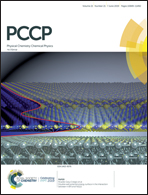Direct evidence of solvent polarity governing the intramolecular charge and energy transfer: ultrafast relaxation dynamics of push–pull fluorene derivatives†
Abstract
Photoinduced charge and energy transfer are significant photophysical processes controlling the efficiency of photosynthesis and molecular electronics. Here, the influence of solvent polarity and excitation wavelength on the dynamics of excited state relaxation pathways of a push–pull chromophore (PXFCN), where phenoxazine and cyano fluorene acted as a donor and an acceptor, respectively, is investigated in detail by using steady state spectroscopy, nanosecond and femtosecond transient absorption spectroscopy and picosecond emission spectroscopy. In acetonitrile (ACN), the steady state emission spectra of PXFCN exhibited three maxima at around 330, 405 and 620 nm covering the complete continuum range (CIE coordinates of 0.32, 0.40) with an absolute quantum yield of ≈0.12. The aggregation induced emission with an increased quantum yield of ≈0.32 was observed in a tetrahydrofuran and water mixture due to the formation of nano-aggregates. Interestingly the steady state and time resolved emission spectra of PXFCN in ACN obtained upon excitation at different wavelengths revealed the presence of both intramolecular charge and energy transfer processes, whereas in cyclohexane (CHX) the emission originated mainly from the local excited state revealing efficient intramolecular energy transfer. The femtosecond transient absorption spectrum in the polar solvent, ACN, shows that the excited state relaxation pathway is controlled by solvent stabilized twisted intramolecular charge transfer dynamics limiting the formation of the triplet state. However in the case of CHX, the charge transfer state formed upon photoexcitation decayed to the triplet state by geminate charge recombination. The nanosecond transient absorption spectra manifest the dominant feature of the triplet state and the charge transfer state in CHX and ACN, respectively, and their complete dynamics were obtained. Thus based on the transient absorption and emission spectra, it is inferred that the intramolecular charge transfer occurring along with the energy transfer is controlled by the polarity of the solvent through conformational changes leading to a favourable position yielding the charge and energy transfer between the donor and acceptor moieties.



 Please wait while we load your content...
Please wait while we load your content...